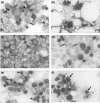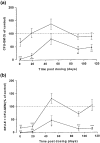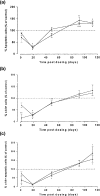A new model of busulphan-induced chronic bone marrow aplasia in the female BALB/c mouse
- PMID: 12694485
- PMCID: PMC2517539
- DOI: 10.1046/j.1365-2613.2003.00239.x
A new model of busulphan-induced chronic bone marrow aplasia in the female BALB/c mouse
Abstract
Aplastic anaemia (AA) is characterized by hypocellular marrow, pancytopenia, and risk of severe anaemia, haemorrhage and infection. AA is often idiopathic, but frequently occurs after exposure to drugs/chemicals. However, the pathogenesis of AA is not clearly understood, and there are no convenient animal models of drug-induced AA. We have evaluated regimens of busulphan (BU) administration in the mouse to produce a model of chronic bone marrow aplasia showing features of human AA. Mice were given 8 doses of BU at 0, 5.25 and 10.50 mg/kg over 23 days; marrow and blood samples were examined at 1, 19, 49, 91 and 112 days after dosing. At day 1 post dosing, in mice treated at 10.50 mg/kg, nucleated marrow cells, CFU-GM and Erythroid-CFU were reduced. Similarly, peripheral blood erythrocytes, leucocytes, platelets and reticulocytes were reduced. At day 19 and 49 post dosing, there was a trend for parameters to return towards normal. However, at day 91 and 112 post dosing, values remained significantly depressed, with a stabilized chronic bone marrow aplasia. At day 91 and 112 post dosing, marrow cell counts, CFU-GM and Erythroid-CFU were decreased; marrow nucleated cell apoptosis and c-kit+ cell apoptosis were increased; peripheral blood erythrocyte, leucocyte, and platelet counts were reduced. We conclude that this is a model of chronic bone marrow aplasia which has many interesting features of AA. The model is convenient to use and has potential in several areas, particularly for investigations on mechanisms of AA pathogenesis in man.
Figures






Similar articles
-
Further development of a model of chronic bone marrow aplasia in the busulphan-treated mouse.Int J Exp Pathol. 2006 Feb;87(1):49-63. doi: 10.1111/j.0959-9673.2006.00455.x. Int J Exp Pathol. 2006. PMID: 16436113 Free PMC article.
-
Characterization of the myelotoxicity of chloramphenicol succinate in the B6C3F1 mouse.Int J Exp Pathol. 2006 Apr;87(2):101-12. doi: 10.1111/j.0959-9673.2006.00460.x. Int J Exp Pathol. 2006. PMID: 16623754 Free PMC article.
-
Haemotoxicity of busulphan, doxorubicin, cisplatin and cyclophosphamide in the female BALB/c mouse using a brief regimen of drug administration.Cell Biol Toxicol. 2011 Feb;27(1):13-40. doi: 10.1007/s10565-010-9167-1. Epub 2010 Jun 30. Cell Biol Toxicol. 2011. PMID: 20589437
-
[Aplastic anemia and pure red cell aplasia].Nihon Rinsho. 2008 Mar;66(3):505-11. Nihon Rinsho. 2008. PMID: 18326319 Review. Japanese.
-
Peripheral blood picture in primary hypocellular refractory anemia and idiopathic acquired aplastic anemia: an additional tool for differential diagnosis.Haematologica. 1997 Jan-Feb;82(1):21-4. Haematologica. 1997. PMID: 9107077 Review.
Cited by
-
The haemotoxicity of mitomycin in a repeat dose study in the female CD-1 mouse.Int J Exp Pathol. 2005 Dec;86(6):415-30. doi: 10.1111/j.0959-9673.2005.00452.x. Int J Exp Pathol. 2005. PMID: 16309546 Free PMC article.
-
The haemotoxicity of azathioprine in repeat dose studies in the female CD-1 mouse.Int J Exp Pathol. 2008 Apr;89(2):138-58. doi: 10.1111/j.1365-2613.2008.00575.x. Int J Exp Pathol. 2008. PMID: 18336531 Free PMC article.
-
Further development of a model of chronic bone marrow aplasia in the busulphan-treated mouse.Int J Exp Pathol. 2006 Feb;87(1):49-63. doi: 10.1111/j.0959-9673.2006.00455.x. Int J Exp Pathol. 2006. PMID: 16436113 Free PMC article.
-
Mesenchymal Stem Cell Benefits Observed in Bone Marrow Failure and Acquired Aplastic Anemia.Stem Cells Int. 2017;2017:8076529. doi: 10.1155/2017/8076529. Epub 2017 Dec 3. Stem Cells Int. 2017. PMID: 29333168 Free PMC article. Review.
-
Seminiferous epithelium damage after short period of busulphan treatment in adult rats and vitamin B12 efficacy in the recovery of spermatogonial germ cells.Int J Exp Pathol. 2016 Aug;97(4):317-328. doi: 10.1111/iep.12195. Epub 2016 Aug 31. Int J Exp Pathol. 2016. PMID: 27578607 Free PMC article.
References
-
- Andrews CM, Dash LM, Williams TC, Craig Gray J, Turton JA. Long-term effects of busulphan on lymphocyte subpopulations in female B6C3F1 mice. Comp. Haematol. Int. 1997;7:230–237.
-
- Andrews CM, Spurling NW, Turton JA. Characterisation of busulphan-induced myelotoxicity in B6C3F1 mice using flow cytometry. Comp. Haematol. Int. 1993;3:538–546.
-
- Andrews CM, Williams TC, Turton JA. Long-term haematological alterations in female B6C3F1 mice treated with busulphan. Comp. Haematol. Int. 1998;8:125–138.
-
- Appelbaum FR, Fefer A. The pathogenesis of aplastic anaemia. Sem. Haematol. 1981;18:241–257. - PubMed
-
- Barnes DWH, Mole RH. Aplastic anaemia in sublethally irradiated mice given allogeneic lymph node cells. Br. J. Haematol. 1967;13:482–491. - PubMed
Publication types
MeSH terms
Substances
LinkOut - more resources
Full Text Sources
Medical

